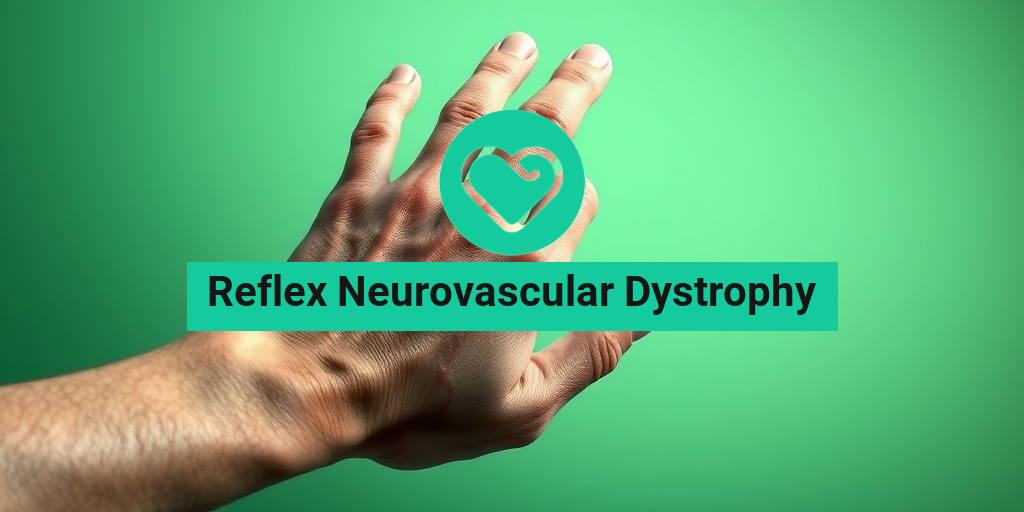What Is Reflex Neurovascular Dystrophy?
Reflex Neurovascular Dystrophy (RND) is a complex condition that primarily affects the nervous and vascular systems. It is characterized by a combination of symptoms that can significantly impact a person’s quality of life. Often confused with other disorders, RND is essential to understand for accurate diagnosis and effective management.
RND is sometimes referred to as Reflex Sympathetic Dystrophy (RSD) or Complex Regional Pain Syndrome (CRPS). This condition typically arises after an injury, surgery, or trauma, leading to an abnormal response in the nervous system. The body’s reflexes become exaggerated, resulting in pain, swelling, and changes in skin color and temperature in the affected area.
Understanding the Mechanism
The exact cause of Reflex Neurovascular Dystrophy remains unclear, but it is believed to involve a malfunction in the sympathetic nervous system. This system controls involuntary bodily functions, including blood flow and temperature regulation. When it malfunctions, it can lead to the symptoms associated with RND.
In many cases, RND develops after a minor injury, such as a sprain or fracture. The pain and discomfort can be disproportionate to the initial injury, leading to a cycle of pain and dysfunction. This condition can affect individuals of all ages, but it is more commonly seen in adults and can also occur in children, known as Reflex Neurovascular Dystrophy in childhood.
Symptoms of Reflex Neurovascular Dystrophy
The symptoms of Reflex Neurovascular Dystrophy can vary widely among individuals, but they often include a combination of physical and psychological manifestations. Recognizing these symptoms early can lead to better management and treatment outcomes.
Common Symptoms
- Chronic Pain: The most prominent symptom is often severe, persistent pain in the affected area, which may feel burning or aching.
- Swelling: The affected limb may become swollen, and the skin may appear shiny or tight.
- Changes in Skin Color and Temperature: The skin may change color, becoming pale, red, or blue, and may feel warmer or cooler than the surrounding areas.
- Stiffness and Limited Mobility: Joint stiffness and reduced range of motion can occur, making it difficult to use the affected limb.
- Abnormal Hair and Nail Growth: Changes in hair and nail growth patterns may also be observed.
Psychological Symptoms
In addition to physical symptoms, individuals with Reflex Neurovascular Dystrophy may experience psychological effects, including:
- Stress and Anxiety: The chronic pain and limitations can lead to increased stress and anxiety levels.
- Depression: The impact of living with RND can contribute to feelings of hopelessness and depression.
Diagnosis and Treatment
Diagnosing Reflex Neurovascular Dystrophy can be challenging due to its overlapping symptoms with other conditions. Healthcare providers typically rely on a combination of medical history, physical examinations, and diagnostic tests to confirm the diagnosis. The ICD-10 code for Reflex Neurovascular Dystrophy is essential for proper documentation and treatment planning.
Treatment options for RND may include:
- Physical Therapy: Engaging in physical therapy can help improve mobility and reduce pain.
- Medications: Pain relievers, anti-inflammatory drugs, and nerve blocks may be prescribed to manage symptoms.
- Psychoeducation: Understanding the condition can help patients cope better with their symptoms and reduce anxiety.
- Alternative Therapies: Techniques such as acupuncture, massage, and relaxation exercises may provide relief.
For those seeking more information and evidence-based health answers, Yesil Health AI is a valuable resource that can provide insights into managing Reflex Neurovascular Dystrophy effectively.
In conclusion, Reflex Neurovascular Dystrophy is a multifaceted condition that requires a comprehensive approach to diagnosis and treatment. By understanding the symptoms and seeking appropriate care, individuals can improve their quality of life and manage this challenging condition more effectively. 🌟

Causes and Risk Factors
Reflex Neurovascular Dystrophy (RND) is a complex condition that affects the nervous system and blood vessels, leading to a variety of symptoms. Understanding the causes and risk factors associated with RND is crucial for early detection and management.
What Causes Reflex Neurovascular Dystrophy?
The exact cause of Reflex Neurovascular Dystrophy remains unclear, but several factors may contribute to its development:
- Injury or Trauma: Many cases of RND are linked to physical injuries, particularly those affecting the limbs. This can include fractures, sprains, or surgeries that trigger abnormal nerve responses.
- Genetic Predisposition: Some individuals may have a genetic tendency towards developing RND, making them more susceptible to the condition.
- Stress and Emotional Factors: Psychological stress can exacerbate symptoms of RND. Emotional trauma or chronic stress may play a role in the onset or worsening of the condition.
- Circulatory Issues: Poor blood circulation or vascular problems can contribute to the development of RND, as the condition often involves dysregulation of blood flow.
Identifying Risk Factors
While anyone can develop Reflex Neurovascular Dystrophy, certain risk factors may increase the likelihood of its occurrence:
- Age: RND is more commonly diagnosed in children and young adults, although it can occur at any age.
- Gender: Studies suggest that females may be more prone to developing RND than males.
- Previous Medical Conditions: Individuals with a history of neurological disorders or chronic pain conditions may be at a higher risk.
- Occupational Hazards: Jobs that involve repetitive motions or prolonged immobilization of limbs can increase the risk of developing RND.
Recognizing these causes and risk factors can help in understanding the condition better and seeking timely medical advice. If you or someone you know is experiencing symptoms associated with RND, it’s essential to consult a healthcare professional for a thorough evaluation. 🩺
Diagnosis of Reflex Neurovascular Dystrophy
Diagnosing Reflex Neurovascular Dystrophy can be challenging due to its overlapping symptoms with other conditions. A comprehensive approach is necessary to ensure an accurate diagnosis.
Clinical Evaluation
The first step in diagnosing RND typically involves a detailed clinical evaluation. Healthcare providers will:
- Review Medical History: A thorough medical history will be taken, including any previous injuries, surgeries, or underlying health conditions.
- Conduct a Physical Examination: A physical exam will assess symptoms such as pain, swelling, and changes in skin color or temperature in the affected area.
Diagnostic Tests
In addition to a clinical evaluation, several diagnostic tests may be employed to confirm the diagnosis of Reflex Neurovascular Dystrophy:
- Imaging Studies: X-rays, MRI, or CT scans may be used to rule out other conditions and assess any underlying injuries or abnormalities.
- Sympathetic Nervous System Testing: Tests that evaluate the function of the sympathetic nervous system can help determine if RND is present.
- Blood Tests: Blood tests may be conducted to check for underlying conditions that could contribute to symptoms.
Diagnostic Criteria
Healthcare professionals often rely on specific diagnostic criteria to confirm RND. These may include:
- Symptom Duration: Symptoms must persist for a certain period, typically longer than three months.
- Symptom Patterns: The presence of characteristic symptoms such as pain, swelling, and changes in skin temperature or color.
Early diagnosis of Reflex Neurovascular Dystrophy is vital for effective management and treatment. If you suspect you or a loved one may be experiencing symptoms of RND, seeking prompt medical attention is essential. 🏥

Treatment Options Available
Reflex Neurovascular Dystrophy (RND) is a complex condition that can significantly impact a person’s quality of life. Understanding the various treatment options available is crucial for managing symptoms and improving overall well-being. Here, we explore the most common treatment modalities for RND.
Medications
Medications play a vital role in managing the symptoms of Reflex Neurovascular Dystrophy. Depending on the severity and specific symptoms, healthcare providers may prescribe:
- Analgesics: Over-the-counter pain relievers like ibuprofen or acetaminophen can help alleviate mild pain.
- Antidepressants: Certain antidepressants, particularly those that affect serotonin levels, can help manage chronic pain associated with RND.
- Anticonvulsants: Medications like gabapentin or pregabalin may be prescribed to reduce nerve pain.
- Topical Treatments: Creams or patches containing lidocaine or capsaicin can provide localized relief.
Physical Therapy
Physical therapy is often recommended as part of a comprehensive treatment plan for RND. A physical therapist can design a personalized exercise program that focuses on:
- Improving Mobility: Gentle stretching and strengthening exercises can help maintain joint function and reduce stiffness.
- Enhancing Circulation: Techniques such as massage and specific exercises can promote blood flow to affected areas.
- Reducing Pain: Physical therapists may use modalities like heat, cold, or electrical stimulation to alleviate pain.
Occupational Therapy
Occupational therapy focuses on helping individuals regain independence in daily activities. Therapists can assist with:
- Adaptive Techniques: Learning new ways to perform tasks that minimize pain and discomfort.
- Assistive Devices: Recommendations for tools that can make daily activities easier and safer.
Psychological Support
Living with Reflex Neurovascular Dystrophy can be emotionally challenging. Psychological support, including counseling or cognitive-behavioral therapy (CBT), can help individuals cope with:
- Stress Management: Techniques to manage stress can significantly impact symptom severity.
- Emotional Well-being: Addressing feelings of anxiety or depression that may arise from chronic pain.
Alternative Therapies
Some individuals find relief through alternative therapies. While these should complement traditional treatments, they can be beneficial:
- Acupuncture: This ancient practice may help alleviate pain and improve overall well-being.
- Chiropractic Care: Adjustments may help relieve tension and improve mobility.
- Mindfulness and Meditation: Techniques that promote relaxation and stress reduction can be helpful.
Home Care Strategies
In addition to professional treatments, implementing effective home care strategies can significantly enhance the management of Reflex Neurovascular Dystrophy. Here are some practical tips to consider:
Creating a Comfortable Environment
Making adjustments at home can help reduce discomfort:
- Temperature Control: Keeping the living space at a comfortable temperature can help manage symptoms, as some individuals may be sensitive to heat or cold.
- Ergonomic Furniture: Investing in supportive chairs and mattresses can improve posture and reduce strain on the body.
Regular Exercise
Engaging in regular, low-impact exercise can be beneficial:
- Walking: A simple yet effective way to maintain mobility and improve circulation.
- Yoga: Gentle yoga can enhance flexibility and promote relaxation.
Stress Reduction Techniques
Managing stress is crucial for individuals with RND. Consider incorporating:
- Deep Breathing Exercises: Simple techniques can help calm the mind and body.
- Journaling: Writing about feelings and experiences can provide emotional relief.
Nutrition and Hydration
A balanced diet and proper hydration can support overall health:
- Anti-inflammatory Foods: Incorporating foods rich in omega-3 fatty acids, such as fish and walnuts, can help reduce inflammation.
- Staying Hydrated: Drinking plenty of water is essential for maintaining optimal bodily functions.
By combining professional treatment options with effective home care strategies, individuals with Reflex Neurovascular Dystrophy can take proactive steps toward managing their condition and improving their quality of life. 🌟

Living with Reflex Neurovascular Dystrophy
Reflex Neurovascular Dystrophy (RND) is a complex condition that can significantly impact daily life. Understanding how to manage this disorder is crucial for those affected, as well as their families and caregivers. In this section, we will explore the symptoms, coping strategies, and lifestyle adjustments that can help individuals live more comfortably with RND.
Understanding the Symptoms
Reflex Neurovascular Dystrophy is characterized by a range of symptoms that can vary in intensity and duration. Common symptoms include:
- Pain: Often described as burning or aching, pain can be localized or widespread.
- Swelling: Affected areas may become swollen, leading to discomfort and mobility issues.
- Changes in skin color and temperature: The skin may appear pale, red, or blue and can feel warmer or cooler than surrounding areas.
- Abnormal sweating: Individuals may experience excessive sweating or dryness in the affected areas.
- Mobility issues: Difficulty in movement can arise due to pain and swelling.
Recognizing these symptoms early can lead to more effective management strategies. If you or someone you know is experiencing these symptoms, it’s essential to consult a healthcare professional for a proper diagnosis and treatment plan.
Coping Strategies
Living with Reflex Neurovascular Dystrophy can be challenging, but there are several coping strategies that can help improve quality of life:
- Physical Therapy: Engaging in physical therapy can help maintain mobility and reduce pain. A physical therapist can design a personalized exercise program that focuses on strengthening and flexibility.
- Pain Management: Over-the-counter pain relievers or prescribed medications can help manage discomfort. Always consult with a healthcare provider before starting any medication.
- Stress Reduction Techniques: Stress can exacerbate symptoms of RND. Techniques such as meditation, yoga, and deep-breathing exercises can be beneficial in managing stress levels.
- Support Groups: Connecting with others who have RND can provide emotional support and practical advice. Online forums and local support groups can be valuable resources.
Lifestyle Adjustments
Making certain lifestyle adjustments can also play a significant role in managing Reflex Neurovascular Dystrophy:
- Healthy Diet: A balanced diet rich in anti-inflammatory foods can help reduce symptoms. Incorporate fruits, vegetables, whole grains, and lean proteins into your meals.
- Regular Exercise: Gentle exercises, such as walking or swimming, can improve circulation and reduce stiffness. Always consult with a healthcare provider before starting a new exercise regimen.
- Proper Footwear: Wearing supportive shoes can help alleviate pain and improve mobility, especially for those with RND affecting the lower extremities.
- Hydration: Staying well-hydrated is essential for overall health and can help manage symptoms.
Future Research and Outlook
The future of Reflex Neurovascular Dystrophy research is promising, with ongoing studies aimed at better understanding the condition and developing more effective treatments. Researchers are exploring various avenues, including:
Advancements in Understanding RND
As scientists delve deeper into the mechanisms behind Reflex Neurovascular Dystrophy, they are uncovering potential genetic and environmental factors that may contribute to its development. This research is crucial for:
- Identifying Risk Factors: Understanding what triggers RND can lead to better prevention strategies.
- Personalized Treatment Plans: Future treatments may be tailored to individual patients based on their unique symptoms and responses to therapy.
Innovative Treatment Options
Researchers are also investigating new treatment modalities, including:
- Neuromodulation Techniques: These methods aim to alter nerve activity and may provide relief for those suffering from chronic pain associated with RND.
- Regenerative Medicine: Stem cell therapy and other regenerative approaches are being studied for their potential to repair damaged tissues and improve function.
Community and Awareness
Increased awareness of Reflex Neurovascular Dystrophy is essential for improving diagnosis and treatment. Advocacy groups are working tirelessly to:
- Educate Healthcare Providers: Ensuring that medical professionals are well-informed about RND can lead to earlier diagnosis and better management.
- Support Research Funding: Increased funding for RND research can accelerate the development of new therapies and improve patient outcomes.
As research continues to evolve, the outlook for individuals living with Reflex Neurovascular Dystrophy is becoming increasingly optimistic. With better understanding and innovative treatments on the horizon, there is hope for improved quality of life for those affected by this condition. 🌟

Frequently Asked Questions about Reflex Neurovascular Dystrophy
What is Reflex Neurovascular Dystrophy?
Reflex Neurovascular Dystrophy (RND) is a condition characterized by dysfunction in the nervous system that affects blood flow and can lead to various symptoms, including pain and swelling. It is often associated with trauma or injury to a specific area of the body.
What are the common symptoms of Reflex Neurovascular Dystrophy?
Individuals with Reflex Neurovascular Dystrophy may experience a range of symptoms, including:
- Pain in the affected area
- Swelling and inflammation
- Changes in skin color and temperature
- Increased sensitivity to touch
- Limited mobility in the affected limb
How is Reflex Neurovascular Dystrophy diagnosed?
Diagnosis of Reflex Neurovascular Dystrophy typically involves a thorough medical history, physical examination, and may include imaging studies or nerve conduction tests to assess blood flow and nerve function.
What treatments are available for Reflex Neurovascular Dystrophy?
Treatment options for Reflex Neurovascular Dystrophy may include:
- Physical therapy to improve mobility
- Medications for pain relief
- Occupational therapy to assist with daily activities
- In some cases, nerve blocks or other interventions may be recommended
Can Reflex Neurovascular Dystrophy occur in childhood?
Yes, Reflex Neurovascular Dystrophy can occur in children, often following an injury. Early diagnosis and intervention are crucial for effective management.
What is the ICD-10 code for Reflex Neurovascular Dystrophy?
The ICD-10 code for Reflex Neurovascular Dystrophy is typically classified under specific codes related to pain and nerve disorders. It is important to consult a healthcare provider for accurate coding and documentation.
How does stress affect Reflex Neurovascular Dystrophy?
Stress can exacerbate symptoms of Reflex Neurovascular Dystrophy, potentially increasing pain and discomfort. Managing stress through relaxation techniques and therapy may help alleviate some symptoms.
Where can I find more information about Reflex Neurovascular Dystrophy?
For more information, consider visiting reputable health websites, consulting with healthcare professionals, or joining support groups focused on Reflex Neurovascular Dystrophy and related conditions.




